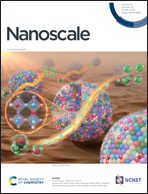In situ study of wet chemical etching of ZnO nanowires with different diameters and polar surfaces by LCTEM†
Abstract
Understanding how nanomaterials evolve during the etching process is critical in many fields. Herein, the wet chemical etching process of zinc oxide (ZnO) nanowires is studied in situ in radiolytic water via liquid cell transmission electron microscopy (LCTEM). The dissolution rate of thin nanowires is constant with reducing diameter, while thick nanowires (with the original diameter being larger than 95 nm) show complicated etching behaviors. The dissolution rate of thick nanowires is constant at the first stage and then increases. Anisotropic etching occurs at both ends of thick nanowires and distinct tips are formed. Different polarities at the two ends of the nanowire lead to differently shaped tips and different tip formation processes. The arrangement of the sidewall cones determines the macroscopic angle of the final tips. The present results are important for understanding liquid phase etching behavior in different dimensions and with different polar ends.



 Please wait while we load your content...
Please wait while we load your content...